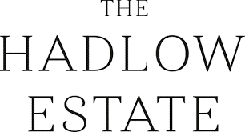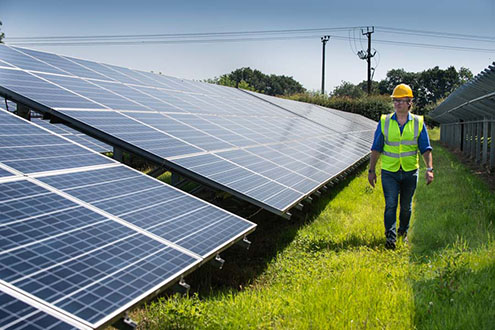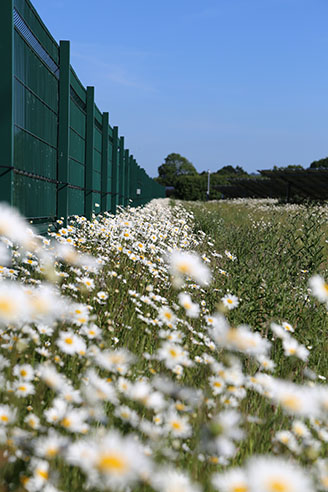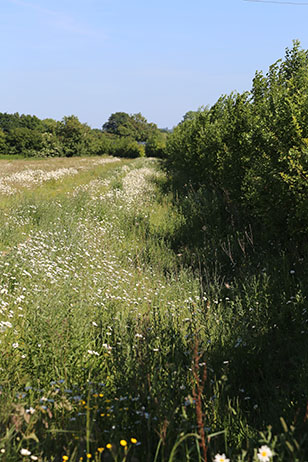Renewable energy on the Hadlow Estate
This post is greater than 6 months old - links may be broken or out of date. Proceed with caution!


The Hadlow Estate has always believed it has a responsibility and role to play in the provision of sustainable clean energy for the local community and could also contribute to the Government’s commitment to reducing carbon emissions and moving away from a reliance on fossil fuels.
In 2014, it brought forward a 64-acre, solar park in Capel next to the London-Ashford railway line, in partnership with British Solar Renewables. The land is leased from the Estate by the solar park owners Cubico Sustainable Investments and GLIL Infrastructure, the park has 72,776 panels.
The land was arable monoculture. The decision to move to renewables on that piece of land came after a careful sieve mapping exercise to establish suitable land with a grid connection and it was part of the Estate’s strategy of careful diversification. It was also due to the Estate’s belief in playing its part in the transition to a low carbon economy and to provide clean, green energy for the local area.
The park now produces enough energy to power 5,200 homes a year with an average annual output of over 182,000,000kWh.
In 2020, it reported its most productive year on record, generating enough electricity to power 5,746 homes in the local area.
This peaked in May 2020, with the site powering around 11,145 homes across the month. To put this figure into context, the electricity generated in May alone would be enough to boil a kettle 104,140,160 times – that’s a lot of cups of tea!

Harry Teacher of the Hadlow Estate said: “When the solar park was constructed in 2014, our aim was to provide a significant amount of green energy for local homes and businesses, so it is fantastic to see we are fulfilling what we set out to achieve. The sunny weather and lower air pollution levels have helped to boost the output considerably. Diversification into renewable energy has been an important aspect of our long term strategy for the Estate as we look to the future. We decided to install solar photovoltaic panels on many of our farm buildings, including at Hadlow Place Farm, Bank Farm Livery Stables and Little Fish Hall. Electricity from these panels runs our cold stores, the Estate and farm office, and a number of houses, including our home. Any unused energy is exported back to the grid but during peak times we use almost all of the clean energy we generate.”
As well as providing much needed green energy locally, the park and its surroundings provide a home for an abundance of wildlife, thanks to its hedges, trees and wildflower meadows. Bird and bat boxes have been installed in nearby woodland and hedgerows to provide roosting sites and nesting opportunities and are already being used.
Harry continued: “Our farm team planted over 5,000 hedgerow shrubs and 200 trees.
The hedgerows which were planted to screen the site are now well established and provide habitats and food sources for a wide range of birds and animals. By linking up with existing treelines these new hedges have created valuable wildlife corridors and enhanced connectivity around and across the site - which is great for biodiversity. Monoculture arable crops have been replaced by grassland, including almost 10 acres of species-rich wildflower meadows full of daisies, clover and scabious and 5 acres of tussocky grass. These meadows are always teeming with insects and are carpeted with flowers in the late spring and summer. In addition to the solar park, the Estate has also diversified into other renewable energy solutions, using its own timber for a small biomass district heating system at Hadlow Place Farm. The biomass boiler is fed by woodchip from the Estate’s sustainable forestry operations and provides heating and hot water to a number of buildings and houses. This holistic approach, of using sustainably grown timber to supply energy locally, allows us to invest back into our woodlands for the long term,”
Kate Teacher of the Hadlow Estate said: “Our advice to anyone looking into renewable energy options would be to do your research, crunch the numbers and get good advice. You have to diversify and take opportunities when they come. Now, more than ever, with fuel security a live issue given the war in Ukraine and the need to transition to a lower carbon future, diversification into renewables and bold thinking is required.”
Find out more about the Estate on www.hadlow.com
Cubico Sustainable Investments is one of the world’s largest privately-owned renewable energy companies, working across the UK, Europe, the Americas and Australia. CJS asked them to provide detail on growth in the sector and the wildlife benefits that can be seen.
Growth since the 2010s
Ground mounted solar was a new development in the UK in the 2010s, although the technology had been deployed in Germany and other European Countries since around 2005. There was a rapid increase in solar developments following the introduction of subsidies such as Feed-In-Tariffs and Ofgem’s Renewable Obligation Certificates, along with the drop in cost of photovoltaic panels. According to the Department of Business, Energy and Industrial Strategy (BEIS) the use of solar PV to generate electricity in the UK has grown rapidly since 2010, increasing capacity from 95MW to 13,800 MW at the end of 2021. There are now also over a million solar commercial and domestic PV installations in the UK. In 2021, solar PV contributed more than 10 per cent of renewable generation and more than 4 per cent of total electricity generation in the UK. (Spry, 2022)

Biodiversity Benefits of Ground Mounted Solar
Ground-mounted solar projects can deliver major benefits to the environment. In addition to providing clean, affordable energy – which is good for the planet – they can improve local biodiversity by supporting new and existing plant and animal life.
Well-designed and managed solar farms contribute to a range of ecosystems. They can support sustainable agriculture, regulate air quality, mitigate flood risk, generate new habitats, and reduce carbon emissions. Solar farms that have been monitored regularly by ecologists demonstrate an increase over time in the local abundance and variety of plants, pollinators, birds, and other wildlife. Panels themselves are set on posts, meaning there is minimal disturbance to the ground (typically around 1-2% of the total site area). This means the rest of the land is available for landowners and operators to take measures that actively improve the local environment and provide a range of ecological benefits. These include:
- Establishing wildflower meadows and grasslands. Solar farms are sited on land which can be used for two things at once, including farming in some cases (sheep can graze under the panels). The areas between panels and the edge of a site can be used to create new habitats for pollinators, butterflies, and ground-nesting birds.
- Supporting new hedgerow planting. Hedgerow loss is a major concern for countryside management around the country. New solar projects aim wherever possible to preserve, restore or plant more hedgerows which provides greater habitat connectivity.
- Promoting wetland habitats. Effective drainage and water management systems are essential for solar farms. As part of this, they can be designed to incorporate wetland habitats. These offer a drainage solution for the site, which reduces local flood risk while supporting terrestrial and aquatic life with wetlands and ponds (UK, 2022)
References:
Spry, W. (2022). Reveiw of Solar PV Capacity Publications. London: Department of Business, Energy and Industrial Strategy.
UK, S. E. (2022). Everything under the sun: The facts about solar energy . London: Solar Energy UK.
More from The Hadlow Estate